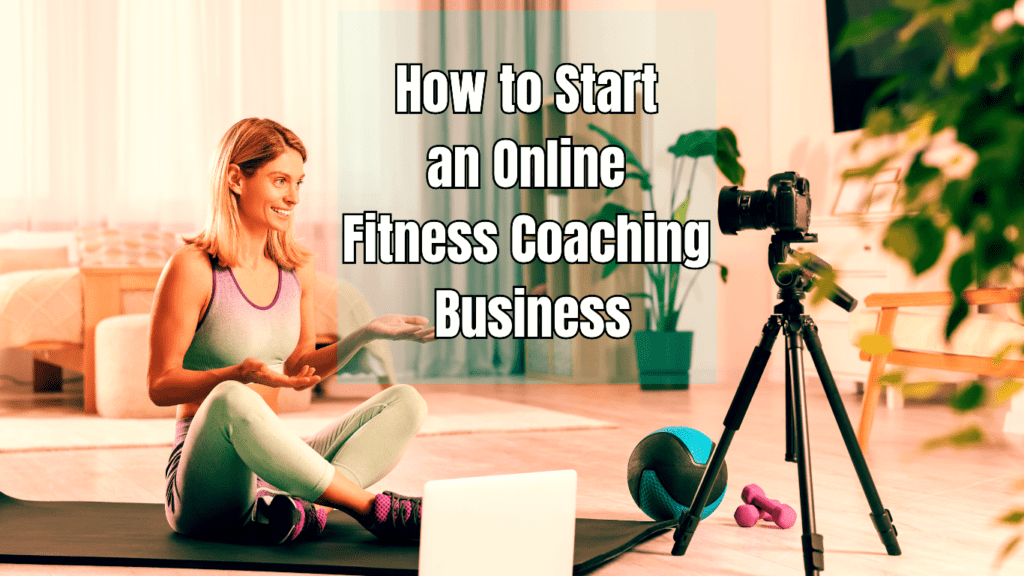How to Start an Online Fitness Coaching Business – The Essential Guide
In this article, we’ll show you how to start an online fitness coaching business from scratch, guiding you through every step to transform your passion into a thriving career.
The online fitness coaching industry is experiencing unprecedented growth. According to recent reports, the global market for online fitness is projected to surpass $60 billion by 2025. This rapid expansion highlights a tremendous opportunity for fitness enthusiasts and professionals looking to break into the digital space. If you’re passionate about fitness and considering starting your own online fitness coaching business, you’re in the right place.

In this comprehensive guide, we’ll explore exactly how to start an online fitness coaching business. Whether you’re a seasoned fitness trainer or new to the industry, this article will provide you with actionable insights and practical steps to launch and grow your own online fitness coaching venture.
Here’s a brief overview of what you can expect:
- Understanding the Market: Learn about the current trends and demand in the online fitness space.
- Defining Your Niche and Target Audience: Discover how to identify your specific area of expertise and the audience you want to reach.
- Developing Your Business Plan: Get tips on creating a solid business plan that outlines your goals, services, and marketing strategy.
- Setting Up Your Online Presence: Find out how to establish a professional online presence with a website and social media.
- Choosing the Right Tools and Technology: Understand the essential tools and platforms you’ll need to run your online business effectively.
- Building a Client Base: Learn strategies for attracting and retaining clients in the competitive online fitness market.
- Providing Value and Maintaining Engagement: Discover methods for delivering exceptional service and keeping clients motivated.
Subscribe And Get Our Free E-Book:Unlocking The Power Of Nutrition-Supplements, Substitutes, and Superfoods!
By the end of this guide, you’ll have a clear roadmap on how to start an online fitness coaching business and set yourself up for success in this dynamic and growing field. Let’s get started on turning your fitness passion into a thriving online coaching business!
Understanding the Online Fitness Coaching Landscape
As you embark on the journey of how to start an online fitness coaching business, it’s crucial to grasp the current landscape of the online fitness industry. This involves examining market trends, identifying your target audience, and conducting competitor analysis. By understanding these aspects, you’ll be better equipped to position your business for success.

Market Trends
The popularity of online fitness coaching has surged in recent years, and this trend shows no signs of slowing down. The convenience and flexibility of virtual workouts appeal to a wide range of individuals, contributing to the booming market. With more people seeking fitness solutions that fit into their busy schedules and preferences, online coaching has become a preferred option.
Several factors contribute to this growth. First, the global shift towards digital solutions has made online fitness more accessible than ever. People are increasingly comfortable using technology for various aspects of their lives, including fitness. Additionally, the COVID-19 pandemic accelerated the adoption of online fitness platforms, as many gyms and studios closed or operated at limited capacity. This shift has left a lasting impact, with many individuals continuing to prefer the convenience of working out from home.
The potential for how to start an online fitness coaching business is significant. With a growing market and an increasing number of people looking for virtual fitness solutions, there is ample opportunity for new coaches to establish themselves. Understanding these trends will help you tap into the right market segments and tailor your services to meet the evolving needs of fitness enthusiasts.
Target Audience
Identifying your target audience is a key component of how to start an online fitness coaching business. Knowing who is seeking online fitness coaching allows you to tailor your offerings and marketing strategies effectively.
One major segment of the online fitness audience includes busy professionals. These individuals often struggle to find time for the gym due to demanding work schedules. Online fitness coaching offers a flexible solution that fits into their lifestyle. They value convenience and are willing to invest in services that allow them to work out at home or during brief breaks in their day.
Another important audience segment is people with limited access to gyms. This group includes individuals who live in remote areas where gym facilities are scarce or non-existent. Online fitness coaching provides these people with access to professional guidance and structured workout programs that they might not otherwise have.
Additionally, individuals recovering from injuries or with specific health conditions often seek online coaching as a safer alternative to in-person sessions. They need customized programs that consider their physical limitations and health concerns, making online coaching an ideal solution for personalized attention.
Understanding these audience segments helps you design your services to meet their unique needs. Whether it’s creating flexible workout schedules for busy professionals or developing specialized programs for those with health issues, aligning your offerings with your target audience will make your online fitness coaching business more appealing and effective.
Competitor Analysis
To successfully navigate how to start an online fitness coaching business, it’s essential to conduct thorough competitor analysis. This process involves researching other online fitness coaches to understand their strengths, weaknesses, and market positioning. By analyzing your competitors, you can identify opportunities to differentiate yourself and find your niche.
Begin by researching existing online fitness coaches. Look at their websites, social media profiles, and service offerings. Pay attention to their marketing strategies, client testimonials, and the types of programs they offer. This will give you insights into what works well in the industry and areas where you can provide something unique.
Analyze the services offered by your competitors. Are they focusing on one-on-one coaching, group classes, or pre-recorded workouts? Do they specialize in a particular fitness area, such as strength training or yoga? Understanding their service range will help you identify gaps in the market that you can fill.
Evaluate their pricing strategies. Compare their pricing models with your planned pricing structure to ensure your rates are competitive while reflecting the value you offer. Consider whether they offer subscription models, package deals, or pay-per-session options, and determine what might work best for your business.
Online Fitness Coach Starting From Scratch Video
Additionally, examine their client engagement and retention strategies. How do they interact with clients? Do they offer personalized support, regular follow-ups, or additional resources? Identifying successful engagement techniques can inspire you to implement similar strategies in your own business.
Finding your niche is a critical part of standing out in the competitive landscape of online fitness coaching. Based on your research, determine how you can differentiate yourself. This could be through specializing in a unique fitness area, offering exceptional client support, or incorporating innovative technology into your services.
In summary, understanding the online fitness coaching landscape involves analyzing market trends, identifying your target audience, and conducting competitor analysis. By gaining insights into these areas, you’ll be well-prepared to launch and grow your online fitness coaching business effectively. The growing popularity of online fitness, coupled with a well-defined target audience and a thorough understanding of your competition, will set the foundation for your success in the industry.
Online Fitness Coaching Industry Overview Chart:
| Category | Sub-Category | Description | Current Trends | Opportunities | Challenges |
|---|---|---|---|---|---|
| Market Trends | Market Size | Over $60 billion by 2025. | Rapid growth and increased digital adoption. | Expanding market for new entrants. | High competition and market saturation. |
| Growth Drivers | Digital shift and COVID-19 impact. | Strong demand for virtual workouts. | Tap into diverse client demographics. | Evolving consumer preferences. | |
| Key Trend | Preference for flexible fitness options. | Increased virtual workout participation. | Create unique offerings to stand out. | Ensuring high client engagement. | |
| Target Audience | Busy Professionals | Professionals with tight schedules. | Need for flexible, on-demand solutions. | Tailor programs for busy lifestyles. | Balancing work and fitness needs. |
| Remote Individuals | Limited access to gyms. | Need for structured online programs. | Offer comprehensive online programs. | Building a fitness community online. | |
| Health-Conscious | Those with specific health needs. | Demand for customized, safe plans. | Develop specialized health programs. | Adapting programs to various health conditions. | |
| Competitor Analysis | Coaching Models | 1-on-1, group, and pre-recorded. | Variety of models in use. | Differentiate through unique offerings. | Competing with established brands. |
| Pricing Models | Subscriptions, pay-per-session, packages. | Flexible pricing to attract clients. | Set competitive and value-based rates. | Balancing costs and competitive pricing. | |
| Engagement Strategies | Personalized support and follow-ups. | Focus on client interaction and community. | Build strong client relationships. | Maintaining engagement in a digital format. | |
| Business Model | Coaching Models | Mix of 1-on-1, group, and pre-recorded. | Scalability and personalization. | Balance various models to meet client needs. | Managing resources across models. |
| Pricing Strategies | Research-based and flexible options. | Competitive and value-based pricing. | Offer varied pricing plans. | Aligning price with value perception. | |
| Revenue Streams | Subscriptions, one-time payments, merchandise. | Multiple income options. | Explore diverse revenue sources. | Integrating multiple streams effectively. |
Explanation of Chart
This chart presents key aspects of the online fitness coaching industry in a clear and concise format:
- Category: Main area of focus (e.g., Market Trends, Target Audience).
- Sub-Category: Specific topic within each category (e.g., Market Size, Busy Professionals).
- Description: Brief summary of the sub-category.
- Current Trends: Key trends relevant to each sub-category.
- Opportunities: Potential advantages or areas for growth.
- Challenges: Main obstacles or issues to consider.
Defining Your Business Model
When considering how to start an online fitness coaching business, defining your business model is a crucial step. Your business model determines how you will deliver your services, how you will price them, and the various ways you will generate revenue. By carefully planning these aspects, you can create a sustainable and profitable online fitness coaching business.

Types of Coaching Models
One of the first decisions you’ll need to make is choosing the type of coaching model that best suits your skills and target audience. Here are some common models to consider:
1-on-1 Coaching: This model involves providing personalized training sessions to individual clients. 1-on-1 coaching allows you to tailor workouts and nutrition plans specifically to each client’s needs and goals. It offers a high level of customization and personal attention, which can be very appealing to clients seeking individualized guidance. However, this model can be time-intensive and may limit the number of clients you can manage simultaneously.
Group Coaching: Group coaching involves leading fitness sessions for multiple clients at once. This model can be conducted virtually via video conferencing platforms, where you guide a group through a workout or provide fitness advice. Group coaching has the advantage of being more scalable compared to 1-on-1 coaching. It allows you to reach more clients simultaneously and often at a lower price point for each participant. However, it may offer less personalized attention and require effective group management skills.
Pre-Recorded Programs: This model involves creating and selling pre-recorded workout videos or programs. Clients purchase access to these programs and follow the workouts on their own schedule. Pre-recorded programs are highly scalable as they can be sold to an unlimited number of clients without additional time investment from you once they are created. This model can also provide a passive income stream. However, it lacks the interactive element of live coaching and may not address individual client needs as effectively.
Pricing Strategies
Setting competitive prices for your services is a key component of how to start an online fitness coaching business. Your pricing should reflect the value you provide while remaining attractive to your target audience. Here are some strategies to consider:
Market Research: Start by researching the pricing of other online fitness coaches. Look at what similar services are charging and evaluate how your offerings compare. Consider factors such as the level of personalization, the quality of the content, and the experience of the coach. This will help you set a competitive price point that aligns with market expectations.
Cost Analysis: Determine the costs associated with delivering your services, including any software or equipment you need, marketing expenses, and your time investment. Ensure that your pricing covers these costs and provides a profit margin.
Value Proposition: Consider the unique value you offer. If you provide specialized expertise or exceptional client support, you may justify a higher price point. Conversely, if you’re starting out and building your reputation, you might opt for a lower introductory price to attract clients.
Flexible Pricing Options: Offer different pricing options to cater to various client needs. For example, you might provide single-session rates for 1-on-1 coaching, monthly subscription plans for group coaching, and a one-time purchase fee for pre-recorded programs. Flexible pricing can help you attract a broader range of clients and accommodate different budgets.
Revenue Streams
Exploring various revenue streams is essential for maximizing income and ensuring the sustainability of your online fitness coaching business. Here are some options to consider:
Subscription Models: This model involves charging clients a recurring fee for ongoing access to your services. Subscriptions can be for access to group coaching sessions, a library of pre-recorded workouts, or a combination of both. Subscriptions provide a steady stream of income and can help build long-term client relationships.
One-Time Payments: Offering one-time payment options for pre-recorded programs or individual coaching sessions allows clients to pay upfront without committing to a long-term contract. This model is straightforward and appeals to clients who prefer flexibility or want to try out your services before committing to a subscription.
Merchandise: Selling branded merchandise, such as workout gear, accessories, or nutritional supplements, can provide an additional revenue stream. Merchandise not only generates income but also helps build your brand and create a sense of community among your clients.
Affiliate Marketing: Partnering with fitness-related brands or products for affiliate marketing can also generate income. You earn a commission for referring clients to products or services that you endorse. This approach requires building a strong online presence and trust with your audience, but it can be a valuable addition to your revenue strategy.
Online Courses and Workshops: Creating and selling specialized courses or workshops can provide a significant revenue boost. These could include in-depth training on specific fitness topics, advanced workout techniques, or holistic wellness approaches. Online courses offer a scalable way to share your expertise and attract clients interested in niche areas of fitness.
Creating a Balanced Model
When defining your business model, it’s important to create a balance between different coaching types, pricing strategies, and revenue streams. This balance will depend on your expertise, target audience, and market demand. Combining multiple models can diversify your income and provide more options for your clients. For example, you might offer 1-on-1 coaching for personalized guidance, group coaching for a community feel, and pre-recorded programs for clients who prefer self-paced workouts.
In summary, defining your business model is a crucial step in how to start an online fitness coaching business. By carefully selecting the types of coaching models, setting competitive pricing, and exploring various revenue streams, you can create a robust and profitable business. Tailoring your model to fit your strengths and the needs of your target audience will set the foundation for a successful online fitness coaching venture.
Building Your Brand: Key Steps in How to Start an Online Fitness Coaching Business
When figuring out how to start an online fitness coaching business, a crucial step is establishing a strong brand identity. This involves defining your brand’s mission, vision, and values, creating a Unique Selling Proposition (USP), and designing impactful brand assets. Each of these components plays a significant role in making your business stand out and resonate with potential clients.

Brand Identity
Mission: Your mission statement is the foundation of your brand. It should clearly define the purpose of your online fitness coaching business. For example, your mission might be to “empower individuals to achieve their fitness goals through customized and accessible online training.” This statement should reflect the core reason for your business’s existence and resonate with your target audience.
Vision: The vision statement outlines where you see your business going in the future. It provides a long-term goal or aspiration that guides your business decisions. A vision might be to “become a leading resource in online fitness, known for innovative and effective coaching methods that inspire a global community.” Your vision helps set the direction for your growth and development.
Values: Your values represent the principles that guide your business practices and client interactions. These could include integrity, commitment, innovation, or customer-focused. Clearly defining your values ensures that your business operates consistently and builds trust with clients who share similar principles.
Creating a Unique Selling Proposition (USP)
A Unique Selling Proposition (USP) distinguishes your online fitness coaching business from competitors. It’s the unique aspect that makes your services stand out. To define your USP:
Identify Your Strengths: Reflect on what you do exceptionally well. This could be a specialized fitness technique, a unique approach to coaching, or a particular area of expertise. For example, you might offer “customized strength training programs designed for busy professionals with limited time.”
Understand Client Needs: Analyze what your target audience is looking for. Are they seeking personalized workouts, flexible scheduling, or expert advice on specific fitness goals? Your USP should address these needs and position you as the ideal solution.
Craft Your Message: Once you’ve identified your USP, create a compelling message that communicates it clearly to your audience. Your message should highlight how your services provide unique benefits that others do not. For example, if your USP is offering high-level fitness coaching with personalized attention, your message could focus on the exceptional level of customization and support you provide.
Designing Your Brand Assets
Logo Design: Your logo is a critical component of your brand’s visual identity. It should be memorable, simple, and reflective of your brand’s personality. Consider working with a professional designer or using design tools to create a logo that stands out and represents your business effectively.
Choosing Brand Colors: Colors play a significant role in conveying your brand’s message and evoking emotions. Choose colors that align with your brand identity. For example, blue might represent trust and professionalism, while green could symbolize health and vitality. Ensure that your color scheme is consistent across all brand materials.
Designing Your Website: Your website serves as the central hub for your online fitness coaching business. It should be designed to enhance user experience and reflect your brand identity. Key elements include:
- Clear Value Proposition: Your homepage should immediately communicate what makes your services unique and why clients should choose you. Highlight your USP prominently.
- Client Testimonials: Showcasing positive feedback from clients helps build credibility and trust. Include testimonials that highlight the success and satisfaction of your clients.
- Easy Navigation: Ensure that your website is easy to navigate with clear menus and links. Visitors should be able to quickly find information about your services, pricing, and how to contact you.
- Mobile Optimization: With many users accessing websites from mobile devices, ensure that your site is mobile-friendly. A responsive design ensures that your website functions well on smartphones and tablets.
Consistency Across Platforms
Maintaining consistency in your branding across all platforms is essential for building a strong and recognizable presence. Your logo, colors, and overall design should be uniform across your website, social media profiles, and marketing materials. This consistency helps reinforce your brand identity and makes it easier for clients to recognize and remember your business.
Engaging Your Audience
Engaging with your audience through content and interactions is also an important part of building your brand. Share valuable fitness tips, success stories, and updates on your social media platforms to keep your audience informed and connected. Engaging content not only showcases your expertise but also fosters a sense of community around your brand.
By focusing on these elements, you’ll be well on your way to creating a strong and effective brand for your online fitness coaching business.
Chart: Key Steps for Starting an Online Fitness Coaching Business
| Category | Aspect | Details | Key Takeaways |
|---|---|---|---|
| Brand Building | Mission | Define your core purpose. Example: “Empower through online training.” | Clearly state your business purpose. |
| Vision | State future goals. Example: “Lead in online fitness innovation.” | Set long-term aspirations. | |
| Values | Core principles (e.g., integrity, innovation). | Build trust with shared values. | |
| USP | What makes you unique. Example: “Custom training for busy professionals.” | Highlight your unique offer. | |
| Brand Assets | Logo: Memorable. Colors: Reflective of your brand. Website: User-friendly. | Create a cohesive and recognizable brand. | |
| Online Presence | Website | DIY (e.g., Wix) vs. Professional development. | Choose based on your needs and budget. |
| Features | Include booking, payment, client portal. | Ensure essential functionalities are included. | |
| Social Media | Instagram: Visual posts. Facebook: Community. TikTok: Short videos. | Use platforms’ strengths for engagement. | |
| Content Creation | Types | Blog posts, videos, tips. | Share valuable and varied content. |
| Consistency | Align with your brand’s voice. | Maintain a cohesive brand message. | |
| Coaching Program | Design | Structured plans with fitness and nutrition. | Offer tailored and comprehensive programs. |
| Delivery | Live sessions, videos, PDFs. | Use formats that suit client preferences. | |
| Tools | Zoom, Trainerize, Google Drive, MyFitnessPal. | Use tools for effective coaching. | |
| Legal & Financial | Registration | Choose a name, structure, register, get permits, EIN. | Ensure all legal requirements are met. |
| Insurance | Professional liability insurance. | Protect against potential risks. |
Explanation
- Category: Main focus area (e.g., Brand Building).
- Aspect: Specific element within the category (e.g., Mission).
- Details: Short description or example.
- Key Takeaways: Core insight or action point.
Setting Up Your Online Presence
When it comes to how to start an online fitness coaching business, establishing a robust online presence is essential for attracting and retaining clients. This involves setting up a professional website, implementing essential features, developing a social media strategy, and creating engaging content. Each of these elements plays a crucial role in making your business visible and accessible to potential clients.
Website Development
DIY Website Builders vs. Professional Web Developers: One of the first decisions in how to start an online fitness coaching business is choosing how to build your website. You have two main options: using DIY website builders like Wix or Squarespace, or hiring a professional web developer.
DIY Website Builders: Platforms like Wix and Squarespace are user-friendly and allow you to create a professional-looking website without extensive technical knowledge. They offer customizable templates, drag-and-drop functionality, and various tools to help you design a website that suits your brand. These platforms are often cost-effective and ideal for those who want to manage their website independently.
Professional Web Developers: Hiring a professional web developer can be a good choice if you have specific design needs or require advanced features. A web developer can create a custom website tailored to your brand’s unique requirements, ensuring a high level of functionality and aesthetic appeal. This option may involve a higher upfront cost but can provide a more polished and personalized result.

Essential Features
When setting up your website for how to start an online fitness coaching business, certain features are essential to ensure it meets your clients’ needs and supports your business operations. Here are some key features to consider:
Booking System: An integrated booking system allows clients to schedule sessions or classes directly through your website. This feature streamlines the appointment process, reduces administrative tasks, and enhances the user experience.
Payment Gateway: A payment gateway is necessary for processing transactions securely online. Ensure that your website is equipped to handle various payment methods, including credit/debit cards and digital wallets. This feature is crucial for managing subscriptions, one-time payments, and other financial transactions.
Client Portal: A client portal provides a secure area where clients can access their personalized workout plans, track their progress, and communicate with you. This feature adds value to your services by offering clients a centralized place to manage their fitness journey.
Social Media Strategy
Leveraging social media platforms is a key component of how to start an online fitness coaching business. Social media helps you reach a broader audience, engage with potential clients, and build your brand. Here’s how to effectively use platforms like Instagram, Facebook, and TikTok:
Instagram: Instagram is highly visual and ideal for sharing workout tips, client success stories, and behind-the-scenes content. Use Instagram Stories and Reels to showcase short, engaging workout videos and fitness advice. Regularly post high-quality images and videos that reflect your brand’s style and values.
Facebook: Facebook is useful for building a community and engaging with clients through groups and events. Create a business page where you can share updates, offer promotions, and interact with your audience. Facebook Groups can be a great way to foster a sense of community among your clients and provide additional value through group discussions and live sessions.
TikTok: TikTok’s short-form video format is perfect for sharing quick fitness tips, workout challenges, and motivational content. Use popular trends and hashtags to increase the visibility of your videos. TikTok’s algorithm can help you reach a large audience quickly, making it a powerful tool for brand awareness.
Content Creation
Creating engaging content is vital for attracting and retaining clients in how to start an online fitness coaching business. High-quality content not only showcases your expertise but also helps build trust and credibility. Here are best practices for content creation:
Blog Posts: Writing blog posts allows you to share valuable fitness information, tips, and advice. Regularly update your blog with content that addresses common fitness questions, provides workout routines, or offers nutritional guidance. Well-written blog posts can improve your website’s search engine ranking and drive organic traffic to your site.
Videos: Videos are highly engaging and can be used to demonstrate exercises, provide workout tutorials, or offer fitness tips. Create a variety of video content, such as workout demos, client testimonials, and live Q&A sessions. Ensure that your videos are high-quality and edited to maintain viewer interest.
Workout Tips: Share practical and actionable workout tips that your audience can incorporate into their fitness routines. These tips can be shared through blog posts, social media updates, or video content. Providing useful advice helps establish you as an expert in your field and adds value to your clients.
Consistency and Branding: Maintain consistency in your content by aligning it with your brand’s voice and values. Consistent branding across all content helps reinforce your identity and ensures that your message is cohesive. Use your brand colors, logo, and style guidelines in all your content to build a recognizable and professional presence.
By effectively setting up your online presence, including developing a professional website, incorporating essential features, leveraging social media, and creating engaging content, you’ll be well-positioned to succeed in how to start an online fitness coaching business. A strong online presence not only helps attract clients but also enhances their experience with your brand, contributing to long-term success.
Developing Your Coaching Program
A key element in how to start an online fitness coaching business is designing a well-structured coaching program that meets the needs of your clients while reflecting your unique expertise. This involves creating a comprehensive program design, choosing effective content delivery methods, and utilizing technology tools that enhance the coaching experience. Let’s explore each of these aspects in detail to help you build a successful coaching program.
Program Design
Structure Your Coaching Programs: Designing an effective coaching program is fundamental to providing value to your clients. Your program should be tailored to address various fitness goals and client needs. Consider structuring your programs into distinct components, such as fitness plans and nutrition advice, to ensure a holistic approach to health and wellness.
Fitness Plans: Create fitness plans that are specific, measurable, achievable, relevant, and time-bound (SMART). Your plans should cater to different fitness levels, from beginners to advanced athletes. Incorporate a variety of workouts, such as strength training, cardio, flexibility exercises, and recovery strategies. Ensure that each plan includes clear instructions, progression guidelines, and modifications for different fitness levels.
Nutrition Advice: Nutrition plays a critical role in achieving fitness goals. Include nutritional guidance as part of your coaching program, offering general advice on healthy eating, meal planning, and dietary strategies. You might provide sample meal plans, tips for balanced nutrition, and guidance on portion control. Ensure that your nutrition advice is evidence-based and tailored to individual needs where possible.

Content Delivery
Choose the Best Format: The way you deliver your coaching content can significantly impact the client experience. Choose formats that align with your coaching style and client preferences. Here are some options:
Live Sessions: Live sessions, conducted via platforms like Zoom or Microsoft Teams, offer real-time interaction and personalized feedback. They allow clients to ask questions, receive immediate guidance, and engage in live workouts or discussions. Live sessions can be scheduled regularly to maintain client engagement and provide ongoing support.
Pre-Recorded Videos: Pre-recorded videos are a flexible option that allows clients to access content at their convenience. You can create workout routines, instructional videos, and educational content that clients can watch and follow on their own time. This format is beneficial for clients with busy schedules or those who prefer to work out independently.
Downloadable PDFs: Providing downloadable PDFs, such as workout plans, nutrition guides, and progress trackers, offers clients tangible resources they can refer to offline. PDFs are useful for delivering structured content that clients can easily print or view on their devices. Ensure that your PDFs are well-designed and easy to navigate.
Technology Tools
Recommended Tools: Utilizing technology tools can enhance the efficiency and effectiveness of your coaching program. Here are some essential tools to consider for delivering coaching sessions and tracking client progress:
Zoom: Zoom is a popular platform for hosting live coaching sessions, group classes, and client consultations. It offers features like video conferencing, screen sharing, and recording capabilities, which are valuable for interactive sessions and maintaining client engagement.
Trainerize: Trainerize is a comprehensive fitness coaching platform that allows you to create and deliver workout plans, track client progress, and communicate with clients. It provides features such as exercise libraries, progress tracking, and client messaging, making it a useful tool for managing your coaching program.
Google Drive: Google Drive offers cloud storage for sharing files, including workout plans, meal guides, and other resources. It allows clients to access documents from any device and provides a collaborative space for sharing feedback and updates.
MyFitnessPal: MyFitnessPal is a popular app for tracking nutrition and fitness progress. It can be integrated into your coaching program to help clients monitor their diet, log workouts, and set goals. By leveraging this tool, you can provide additional support and insights into clients’ nutrition and exercise habits.
Engagement and Support
Beyond the tools and formats, client engagement and support are critical for the success of your coaching program. Regularly check in with clients to assess their progress, address any challenges they might face, and adjust their programs as needed. Encourage clients to provide feedback on your coaching methods and content delivery to ensure that you are meeting their needs effectively.
Personalization
Personalizing your coaching program enhances the client experience and improves results. Tailor your fitness plans and nutrition advice to individual goals, preferences, and limitations. By offering customized solutions, you demonstrate a commitment to each client’s success and foster a stronger connection with them.
Flexibility
Offering flexible options within your coaching program can accommodate varying client schedules and preferences. Consider providing options for different types of workouts, meal plans, and content delivery methods. Flexibility helps clients stay engaged and committed to their fitness journey.
By focusing on these aspects, you will be well-prepared to develop a comprehensive and effective coaching program as part of how to start an online fitness coaching business. A well-designed program, combined with the right delivery methods and technology tools, will support your clients’ success and contribute to the overall growth and impact of your online fitness coaching business.
Legal and Financial Considerations
When it comes to how to start an online fitness coaching business, understanding the legal and financial aspects is crucial for ensuring compliance and smooth operation. This involves registering your business, obtaining the necessary insurance, and managing your finances effectively. Here’s a detailed look at each of these important areas.
Business Registration
Steps to Register Your Business: Registering your business is a foundational step in how to start an online fitness coaching business. This process varies depending on your location but generally involves several key steps:
1. Choose a Business Name: Select a name that reflects your brand and is not already in use. Ensure it’s unique and adheres to local business naming regulations.
2. Decide on a Business Structure: Choose a business structure that best suits your needs. Common options include sole proprietorship, partnership, limited liability company (LLC), or corporation. Each structure has different implications for liability, taxes, and management.
3. Register with Local Authorities: Register your business with the appropriate local or state authorities. This may involve filing paperwork with a business registry or licensing office.
4. Obtain Necessary Licenses and Permits: Depending on your location and the nature of your services, you may need specific licenses or permits to operate legally. Check with local government offices to determine what’s required.
5. Get an Employer Identification Number (EIN): If you’re in the U.S., you’ll need an EIN from the IRS for tax purposes. This number is essential for opening a business bank account and filing taxes.

Insurance
Types of Insurance You May Need: Insurance is a critical aspect of how to start an online fitness coaching business. It protects you and your business from potential risks and liabilities. Here are some types of insurance to consider:
1. Professional Liability Insurance: Also known as errors and omissions insurance, this coverage protects you in case of claims related to negligence, mistakes, or failures in providing professional services. It’s particularly important for fitness coaches as it covers legal costs if a client claims that your advice led to injury or loss.
2. General Liability Insurance: This insurance covers claims of bodily injury or property damage that occur during the course of your business operations. Even if you operate online, accidents can happen, and this insurance helps protect you against such claims.
3. Cyber Liability Insurance: As an online fitness coach, you handle sensitive client information. Cyber liability insurance protects you against risks related to data breaches and cyber-attacks, covering costs associated with data loss, breaches, and legal fees.
4. Business Property Insurance: If you have physical assets like office equipment or supplies, business property insurance covers damage or loss due to events like fire, theft, or natural disasters.
Financial Management
Basic Accounting Tips: Effective financial management is essential in how to start an online fitness coaching business. Here are some basic accounting tips to keep your finances in order:
1. Keep Detailed Records: Maintain accurate records of all income and expenses. Use accounting software or apps to track transactions, manage invoices, and monitor your financial health.
2. Separate Personal and Business Finances: Open a separate business bank account to manage your business finances. This separation helps keep your personal and business expenses distinct, making it easier to track and report your financial activities.
3. Set a Budget: Create a budget to manage your expenses and allocate funds for marketing, software, equipment, and other business needs. Regularly review and adjust your budget based on actual expenses and income.
4. Monitor Cash Flow: Keep a close eye on your cash flow to ensure you have enough funds to cover your operating expenses. Regularly review cash flow statements to identify any potential issues and make adjustments as needed.
Setting Up a Business Bank Account: Opening a business bank account is a crucial step in how to start an online fitness coaching business. A dedicated business account offers several advantages:
1. Professionalism: A business bank account enhances your professional image and simplifies financial transactions with clients and vendors.
2. Ease of Tracking: Separating personal and business finances makes it easier to track business expenses, manage cash flow, and prepare for tax season.
3. Financial Management Tools: Many business accounts offer tools and features that can assist with financial management, such as online banking, expense tracking, and financial reporting.
Managing Taxes: Proper tax management is essential for compliance and financial health. Here are some tips for managing taxes in your online fitness coaching business:
1. Understand Your Tax Obligations: Familiarize yourself with local, state, and federal tax requirements. This includes income tax, self-employment tax, and sales tax if applicable.
2. Keep Track of Deductions: Identify and track business-related deductions, such as expenses for marketing, equipment, and software. Deductions can reduce your taxable income and lower your tax liability.
3. Estimate Quarterly Taxes: As a self-employed individual, you may need to make estimated quarterly tax payments. Calculate and set aside funds to cover these payments to avoid penalties and interest.
4. Seek Professional Advice: Consider consulting with a tax professional or accountant to ensure you’re meeting all tax requirements and optimizing your tax strategy. An expert can provide guidance on tax planning, deductions, and compliance.
By addressing these legal and financial considerations, you’ll be better equipped to navigate the complexities of how to start an online fitness coaching business. Ensuring that you have proper business registration, insurance, and financial management practices in place will help you operate your business smoothly and protect yourself from potential risks.
Marketing and Client Acquisition
When considering how to start an online fitness coaching business, mastering marketing and client acquisition is pivotal to your success. Effectively promoting your services, attracting new clients, and building strong relationships are essential for growing and sustaining your business. Here’s a comprehensive guide on marketing strategies, client acquisition methods, and building lasting client relationships.
Marketing Strategies
Effective Ways to Market Your Business Online: Marketing your online fitness coaching business involves utilizing various online platforms and strategies to reach your target audience. Here are some key methods to consider:
1. Search Engine Optimization (SEO): SEO is crucial for improving your website’s visibility on search engines like Google. Optimize your website with relevant keywords, including phrases related to fitness coaching and specific services you offer. Focus on creating high-quality content, such as blog posts and articles, that provides value to your audience and addresses common fitness questions. Additionally, ensure that your website’s technical aspects, such as page speed and mobile compatibility, are optimized for better search rankings.
2. Email Marketing: Email marketing is a powerful tool for nurturing leads and maintaining communication with clients. Build an email list by offering valuable content or resources in exchange for email sign-ups. Send regular newsletters that include fitness tips, updates on your services, and special offers. Personalize your emails to make them relevant to your subscribers and encourage engagement with targeted campaigns.
3. Paid Ads: Paid advertising can help you reach a broader audience quickly. Platforms like Google Ads and social media channels (e.g., Facebook, Instagram) offer targeted advertising options that allow you to reach specific demographics. Create compelling ad copy and visually appealing graphics to capture attention. Monitor the performance of your ads and adjust your strategy based on the results to maximize your return on investment.
4. Content Marketing: Develop and share valuable content to position yourself as an authority in the fitness industry. This can include blog posts, instructional videos, workout guides, and success stories. Content marketing not only helps attract potential clients but also builds trust and credibility. Share your content across social media platforms and other relevant channels to increase its reach and impact.
Client Acquisition
How to Attract and Retain Clients: Attracting new clients and retaining existing ones are critical components of how to start an online fitness coaching business. Here are effective strategies to achieve both:
1. Free Trials: Offering free trials is an excellent way to introduce potential clients to your services. Free trials allow prospects to experience your coaching style and the value you provide without any commitment. Promote your free trial offer on your website and social media platforms to attract new clients. Ensure that the trial period provides a comprehensive overview of what clients can expect from your full programs.
2. Referral Programs: Encourage your current clients to refer friends and family by implementing a referral program. Offer incentives such as discounts, free sessions, or exclusive content for each successful referral. A well-structured referral program can help you leverage word-of-mouth marketing, which is often highly effective in acquiring new clients.
3. Partnerships and Collaborations: Partner with other fitness professionals, influencers, or local businesses to expand your reach. Collaborations can include joint webinars, guest blog posts, or social media takeovers. These partnerships can introduce you to new audiences and provide additional credibility to your coaching services.
4. Webinars and Workshops: Host webinars and workshops on fitness-related topics to showcase your expertise and attract potential clients. Offer valuable insights, practical tips, and interactive Q&A sessions. Promote these events through your website, email list, and social media to generate interest and engage with a broader audience.
Building Client Relationships
Tips for Maintaining Strong Relationships with Clients: Building and maintaining strong client relationships is crucial for the success of how to start an online fitness coaching business. Strong relationships lead to higher client retention and satisfaction. Here are some tips for fostering lasting connections:
1. Regular Check-Ins: Schedule regular check-ins with your clients to monitor their progress, address any concerns, and provide support. These check-ins can be conducted via video calls, phone calls, or messaging platforms. Regular communication helps clients feel valued and ensures that you are actively involved in their fitness journey.
2. Personalized Feedback: Provide personalized feedback and guidance based on each client’s unique needs and goals. Tailor your recommendations to their specific circumstances, and acknowledge their achievements and progress. Personalized feedback demonstrates your commitment to their success and enhances their overall experience.
3. Celebrate Milestones: Recognize and celebrate client milestones and achievements, whether it’s reaching a fitness goal, completing a program, or showing consistent progress. Celebrations can be as simple as sending a congratulatory message or offering a small reward. Celebrating milestones helps motivate clients and reinforces their commitment to your coaching program.
4. Offer Continuous Support: Ensure that clients have access to ongoing support and resources. This can include providing additional workout tips, answering questions, and offering guidance on overcoming obstacles. Continuous support helps clients stay engaged and committed to their fitness journey, leading to higher satisfaction and retention.
5. Seek Feedback: Regularly solicit feedback from your clients to understand their needs, preferences, and areas for improvement. Use surveys, feedback forms, or informal conversations to gather insights. Act on the feedback you receive to enhance your services and address any issues that clients may have.
By implementing effective marketing strategies, acquiring new clients through targeted efforts, and building strong client relationships, you will be well on your way to succeeding in how to start an online fitness coaching business. Each of these elements plays a crucial role in growing your business, ensuring client satisfaction, and establishing a solid foundation for long-term success.
Scaling Your Online Fitness Coaching Business: A Guide on How to Start an Online Fitness Coaching Business
As you embark on how to start an online fitness coaching business, scaling your operations effectively is essential for long-term success and growth. Once your business is established and running smoothly, you’ll want to explore strategies for expansion, automation, and continuous improvement. Here’s a guide to help you scale your online fitness coaching business efficiently.
Expansion Strategies
How to Grow Your Business: Expanding your business involves increasing your offerings and capacity to serve more clients. Here are several strategies to consider:
1. Adding New Services: Diversify your service offerings to attract a broader audience and meet varying client needs. Consider introducing additional types of coaching, such as specialized fitness programs, wellness consultations, or group training sessions. For example, if you primarily offer one-on-one coaching, adding group classes or nutrition counseling could provide more value to your clients and attract new ones. Ensure that any new services align with your expertise and business goals.
2. Hiring Additional Coaches: As your client base grows, you may need to hire additional coaches to manage the increased demand. Look for qualified professionals who share your values and can complement your skills. Properly vet candidates and provide them with training to ensure they uphold the standards of your coaching program. Hiring additional coaches allows you to offer more personalized attention and expand your reach.
3. Expanding Your Market Reach: Consider reaching out to new markets or demographics. This could involve targeting different age groups, fitness levels, or geographical locations. You might also explore international markets if you offer services in multiple languages or have the capacity to work with clients in different time zones. Expanding your market reach can significantly increase your client base and revenue.
4. Developing Partnerships: Form partnerships with other fitness professionals, health-related businesses, or influencers to broaden your network and enhance your credibility. Collaborations can include co-hosting events, creating joint content, or offering bundled services. Strategic partnerships can help you tap into new client pools and elevate your brand’s visibility.

Automation
Tools and Techniques for Automating Tasks: Automation is a powerful tool for improving efficiency and managing your online fitness coaching business effectively. Implementing the right tools can save time, reduce manual tasks, and streamline operations:
1. Scheduling: Use scheduling tools to automate appointment bookings and manage your calendar. Platforms like Acuity Scheduling or Calendly allow clients to book sessions, choose from available time slots, and receive automated reminders. This reduces administrative work and helps prevent scheduling conflicts.
2. Follow-Ups: Automate follow-up communications with clients using email marketing platforms or customer relationship management (CRM) systems. Tools like Mailchimp or HubSpot can send automated emails for client onboarding, session reminders, progress updates, and feedback requests. Automation ensures that clients receive timely and consistent communication without requiring constant manual effort.
3. Payments and Invoicing: Implement payment processing and invoicing tools to handle financial transactions efficiently. Platforms such as Stripe or PayPal can automate billing, manage subscriptions, and generate invoices. Automated payment processing reduces administrative overhead and helps ensure timely payments.
4. Client Progress Tracking: Use software to track client progress and manage their fitness data. Tools like Trainerize or MyFitnessPal can automate progress tracking, workout logging, and goal setting. Automation of these processes allows you to focus on providing personalized coaching rather than managing data manually.
Continuous Improvement
How to Stay Updated with Industry Trends: To maintain a competitive edge and continuously improve your offerings, staying informed about industry trends and best practices is crucial:
1. Engage in Professional Development: Invest in ongoing education and training to keep your skills and knowledge up to date. Attend workshops, webinars, and conferences related to fitness coaching and business management. Certifications in new fitness methodologies or technologies can enhance your credibility and expand your service offerings.
2. Monitor Industry Trends: Stay informed about emerging trends and innovations in the fitness industry. Follow industry leaders, read relevant publications, and participate in online forums or groups. Understanding trends such as new workout techniques, dietary recommendations, or technological advancements can help you adapt your services to meet evolving client expectations.
3. Collect Client Feedback: Regularly seek feedback from clients to identify areas for improvement. Use surveys, reviews, or direct conversations to gather insights into their experiences and satisfaction. Analyze the feedback to make informed decisions about enhancing your programs, services, or client interactions.
4. Analyze Business Performance: Track key performance indicators (KPIs) to assess the effectiveness of your business strategies. Monitor metrics such as client retention rates, revenue growth, and program success rates. Use this data to make data-driven decisions and refine your approach to scaling your business.
5. Innovate Your Offerings: Continuously evaluate and update your coaching programs and services. Introduce new features, enhance existing programs, and explore creative ways to add value for your clients. Innovation keeps your business dynamic and appealing, helping you attract and retain clients in a competitive market.
Scaling your online fitness coaching business effectively requires a thoughtful approach to expansion, automation, and continuous improvement. By implementing these strategies, you can grow your business, enhance operational efficiency, and provide exceptional value to your clients. As you progress, remember that how to start an online fitness coaching business is an ongoing journey that involves adapting and evolving to meet the needs of your clients and the demands of the industry.
Overcoming Common Challenges in How to Start an Online Fitness Coaching Business
Starting an online fitness coaching business presents exciting opportunities, but it also comes with its share of challenges. Knowing how to navigate these obstacles is crucial for ensuring the long-term success and smooth operation of your business. Here’s a detailed guide on overcoming some common challenges you might encounter when figuring out how to start an online fitness coaching business.
Technical Issues
Troubleshooting Common Technical Problems: Technical issues can be a significant hurdle in the online fitness coaching realm, potentially affecting your ability to deliver seamless services. Here are some common problems and how to address them:
1. Connectivity Problems: Ensure that your internet connection is stable and reliable. Use a wired connection rather than relying solely on Wi-Fi to reduce the risk of interruptions. Additionally, have a backup internet solution, such as a mobile hotspot, ready in case of connectivity issues during live sessions.
2. Platform Glitches: Technical issues with your coaching platform or website can disrupt client interactions. Regularly update and maintain your software and platforms to ensure they are running smoothly. If issues arise, work with the platform’s support team to resolve them quickly. It’s also wise to familiarize yourself with basic troubleshooting steps and have a support plan in place.
3. Data Security: Protecting client data is paramount. Use secure platforms for storing and processing sensitive information. Implement strong passwords, encryption, and other security measures to safeguard client data. Regularly review and update your security practices to stay ahead of potential threats.
4. User Experience Issues: Ensure that your website and coaching tools are user-friendly. Conduct regular usability tests and gather feedback from clients to identify any issues. Make necessary adjustments to improve the user experience and make it easier for clients to navigate your services.
Client Retention
Strategies for Keeping Clients Engaged and Motivated: Retaining clients is a critical aspect of how to start an online fitness coaching business. Effective client retention strategies can help you maintain a loyal client base and encourage long-term commitment:
1. Personalization: Tailor your coaching programs and communication to meet the individual needs and goals of each client. Personalized workouts, nutrition plans, and feedback help clients feel valued and understood. Adjust your approach based on client progress and feedback to keep them engaged.
2. Regular Communication: Maintain consistent contact with your clients through regular check-ins, progress updates, and motivational messages. Use various communication channels, such as email, messaging apps, or video calls, to stay connected. Regular communication helps build a strong relationship and keeps clients motivated.
3. Reward Systems: Implement reward systems to recognize and celebrate client achievements. Offer incentives such as discounts, additional sessions, or exclusive content for reaching milestones or showing dedication. Rewards help keep clients motivated and reinforce their commitment to your coaching program.
4. Community Building: Foster a sense of community among your clients by creating online groups or forums where they can interact, share experiences, and support each other. Building a community enhances client engagement and provides additional motivation through peer support.
5. Continual Improvement: Regularly update and improve your coaching programs based on client feedback and industry trends. Offering new and innovative services keeps clients interested and invested in their fitness journey. Stay adaptable and open to changes to ensure that your programs remain relevant and effective.

Time Management
Balancing Multiple Responsibilities and Avoiding Burnout: Managing multiple aspects of an online fitness coaching business can be overwhelming. Effective time management is essential for maintaining a healthy work-life balance and avoiding burnout. Here’s how to manage your time effectively:
1. Prioritize Tasks: Identify and prioritize the most important tasks and responsibilities in your business. Focus on high-impact activities that directly contribute to your clients’ success and your business growth. Use tools like to-do lists or task management apps to stay organized and on track.
2. Set Boundaries: Establish clear boundaries between work and personal life. Set specific working hours and avoid checking work-related emails or messages outside of these hours. Clear boundaries help prevent burnout and ensure you have time for rest and relaxation.
3. Delegate Responsibilities: As your business grows, consider delegating tasks to others. Hiring administrative support, virtual assistants, or additional coaches can help you manage your workload and focus on high-priority activities. Delegating responsibilities allows you to concentrate on areas where your expertise is most needed.
4. Use Time Management Tools: Utilize time management tools and techniques to improve efficiency. Calendar apps, scheduling tools, and productivity apps can help you plan and organize your time effectively. Automate repetitive tasks where possible to free up more time for client interactions and business development.
5. Practice Self-Care: Prioritize your own well-being to avoid burnout. Regular exercise, healthy eating, and adequate rest are crucial for maintaining your physical and mental health. Take time for yourself and engage in activities that help you relax and recharge.
6. Review and Adjust: Regularly review your schedule and workload to identify areas for improvement. Assess what is working well and what needs adjustment. Be flexible and willing to make changes to optimize your time management and business operations.
By addressing technical issues, implementing effective client retention strategies, and mastering time management, you can overcome common challenges associated with how to start an online fitness coaching business. Each of these areas plays a crucial role in ensuring the smooth operation of your business and fostering long-term success. As you navigate these challenges, remain focused on providing exceptional value to your clients and continuously improving your services.
Launching Your Online Fitness Coaching Business: A Motivational Guide to Success
As you have explored throughout this comprehensive guide on how to start an online fitness coaching business, you’ve gained valuable insights into building a successful online fitness coaching venture. From understanding the landscape and defining your business model to developing your brand and overcoming common challenges, you now have a solid foundation to embark on your entrepreneurial journey.
Recap and Motivation
Reflecting on what we’ve covered, you’ve learned how to analyze market trends, identify your target audience, and differentiate yourself from competitors. You’ve discovered how to design a business model that suits your goals, create a compelling brand identity, and set up an effective online presence. The guide also provided strategies for developing engaging coaching programs, handling legal and financial aspects, and scaling your business. Finally, you learned how to manage challenges related to technology, client retention, and time management.
Starting an online fitness coaching business requires dedication and passion, but remember that every successful venture begins with a single step. As you prepare to turn your vision into reality, stay motivated by focusing on the positive impact you can have on your clients’ lives. Your unique approach and commitment to fitness will set you apart in a thriving industry.

Step-by-Step Action Plan
1. Research and Plan: Begin by conducting thorough research to understand the online fitness coaching landscape. Identify your target audience and analyze your competitors. Develop a detailed business plan that outlines your goals, services, pricing strategies, and marketing approach.
2. Define Your Business Model: Choose the coaching models that align with your expertise and business goals. Decide on the structure of your services, whether it’s one-on-one coaching, group sessions, or pre-recorded programs. Set competitive pricing and explore various revenue streams to ensure financial sustainability.
3. Build Your Brand: Create a strong brand identity by defining your mission, vision, and values. Develop a unique selling proposition that highlights what sets you apart from other coaches. Design your brand assets, including a memorable logo, brand colors, and a professional website.
4. Set Up Your Online Presence: Develop a user-friendly website with essential features such as a booking system, payment gateway, and client portal. Implement a social media strategy to promote your services and engage with potential clients. Create high-quality content that resonates with your audience and showcases your expertise.
5. Develop Your Coaching Program: Structure your coaching programs to offer valuable and personalized fitness plans, nutrition advice, and other services. Choose the best content delivery formats, such as live sessions, pre-recorded videos, or downloadable materials. Select technology tools that facilitate effective coaching and client progress tracking.
6. Address Legal and Financial Considerations: Register your business and comply with local regulations. Obtain necessary insurance, such as professional liability insurance, to protect yourself and your clients. Set up a business bank account, implement basic accounting practices, and manage your taxes effectively.
7. Implement Marketing and Client Acquisition Strategies: Utilize effective marketing strategies to promote your business online, including SEO, email marketing, and paid ads. Attract and retain clients through free trials, referral programs, and personalized engagement. Build strong client relationships with regular check-ins and personalized feedback.
8. Scale Your Business: Explore expansion opportunities by adding new services, hiring additional coaches, and reaching new markets. Automate tasks and processes to improve efficiency and manage your workload. Stay updated with industry trends and continuously enhance your offerings to stay competitive.
Encouragement and Resources
Taking the first step towards starting your online fitness coaching business can be daunting, but it’s also an exciting opportunity to create something meaningful. Start with small, manageable tasks, and gradually build up your business. Your dedication and hard work will pave the way for success.
To help you get started, we offer additional resources, including a downloadable checklist to guide you through the initial setup process. You can also schedule a consultation for personalized advice and support as you launch your business.
Glossary
- Business Model: The plan or framework for how your business will make money and deliver services.
- Unique Selling Proposition (USP): The distinct feature or benefit that sets your business apart from competitors.
- SEO (Search Engine Optimization): Techniques used to improve your website’s visibility in search engine results.
- CRM (Customer Relationship Management): Software used to manage interactions with current and potential clients.
- Payment Gateway: An online service that processes payments for transactions made on your website.
- Automate: Using technology to perform tasks with minimal manual intervention.
With this final part of your guide, you are equipped to take actionable steps and make informed decisions as you embark on how to start an online fitness coaching business. Embrace the journey with confidence and enthusiasm, knowing that you have the tools and knowledge to build a thriving online fitness coaching business.


